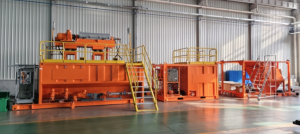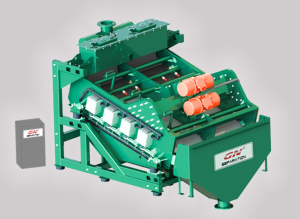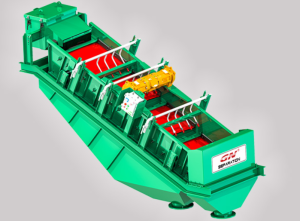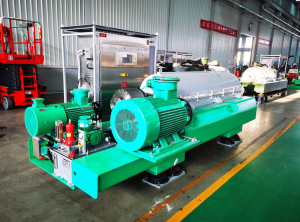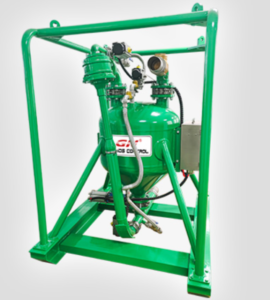At GN Separation, we specialize in providing innovative solutions for industrial separation needs. With over 10 years of experience, we have earned a strong reputation for delivering high-performance equipment. One of our standout products is the GN 3 Phase Decanter Centrifuge, designed for efficient solid-liquid-liquid separation. Recently, we have successfully shipped this cutting-edge technology to a client in South America, offering them a reliable solution for their oily sludge treatment process.
Three-Phase Separation Solution for Oily Sludge Treatment
Our GN 3 Phase Decanter Centrifuge is the perfect solution for industries that require the separation of oil, water, and solids. It excels in separating these three phases, ensuring a clean and efficient output, whether it’s for oil recovery, wastewater treatment, or other industrial applications.
This 3 Phase Decanter Centrifuge operates based on the principle of sedimentation, where the solid particles and two immiscible liquid phases with different densities are separated under high centrifugal force. When the mixture enters the high-speed rotating drum, the material is subjected to centrifugal force, causing the heaviest particles (solids) to settle first, followed by the heavier liquid phase (water), and finally the lighter liquid phase (oil).
The machine’s unique design includes a driving system, decanter bowl, screw conveyor, cover box, skid, and VFD control panel, allowing it to operate continuously for 24 hours, ensuring seamless and efficient performance. The GN 3 Phase Decanter Centrifuge can handle feed materials with less than 10% solids and particle sizes of less than 2mm, making it suitable for a variety of industrial applications, including oil recovery from oily sludge.
Modular Design for Complete Oil Sludge Treatment
Our solution for oily sludge treatment is built around three key modules:
-
Mud Conveying Module
The mud conveying system ensures a smooth flow of materials to the decanter centrifuge. The equipment is designed to transport sludge efficiently, preparing it for the separation process. This system helps minimize material loss and optimizes overall processing time. -
Tank Cleaning and Sludge Settling Module (Slant Plate Clarifier)
GN Separation’s Slant Plate Clarifiers play a key role in washing and settling oil tank sludge. This module helps separate the bulk of solids and water before the material is sent to the decanter centrifuge. By utilizing inclined plates, this system accelerates the settling process, improving the efficiency of the subsequent separation stages. -
Three-Phase Decanter Centrifuge Module
The GN 3 Phase Decanter Centrifuge is the heart of the separation process. Its high-performance design ensures efficient separation of oil, water, and solids. This technology is crucial for industries that need to recover oil from sludge while separating water and solids for proper disposal or treatment.
Specifications of GN 3 Phase Decanter Centrifuge
Our GN 3 Phase Decanter Centrifuge is available in various models, with the following specifications:
- Model Options: GNLWS-364, GNLWS-454, GNLWS-554
- Capacity: 5 m³/h, 10 m³/h, 15 m³/h
- Max Speed: Up to 3986 RPM
- Max G Force: Up to 3200 G
- Main Drive Power: From 22 KW to 75 KW
- Material: Duplex Stainless Steel SS2205
- Screw Conveyor Wear Protection: Tungsten Carbide Tiles
These specifications make the GN 3 Phase Decanter Centrifuge an ideal choice for various industries, including oil recovery, chemical processing, and wastewater treatment. The equipment is highly customizable, offering adjustable separation mechanisms to meet specific client needs, such as the proportion of the two liquid phases.
Adjustable Separation for Flexible Operation
The GN 3 Phase Decanter Centrifuge also features an adjustable impeller that allows operators to fine-tune the separation process based on the proportion of the two liquid phases. This flexibility helps optimize the separation results and ensures high efficiency throughout the operation. The adjustable impeller allows for easy modification of the separation line during ongoing operations, making it suitable for varying conditions.
A Successful Partnership with South American Clients
This recent shipment to a South American customer showcases GN Separation’s ability to meet the diverse needs of clients around the world. By providing high-quality equipment and support, we are proud to assist our customers in improving their operations and achieving better separation results in oily sludge treatment.
At GN Separation, we look forward to expanding our global presence and continuing to deliver cutting-edge separation solutions to clients across the globe. Whether you’re handling oil sludge, wastewater, or any other industrial separation challenge, our technology is designed to provide efficient, reliable, and cost-effective results.
For more information on our GN 3 Phase Decanter Centrifuge and other separation solutions, feel free to contact us. We are always here to help with your separation needs.
GN Separation looks forward to working with you.
